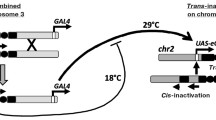Abstract
A number of mutations at the cut locus were induced by non-precise exision of a silent P-element insertion which resulted in deletions at the regulatory region of the locus. Unexpectedly, a reversion of one of these mutations was found, which appears as a result of insertion of Stalker (a retrovirus-like mobile element) near the 1.3 kb deletion. Thus an insertion of a retrovirus-like mobile element can suppress the deficiency at the regulatory region of a gene.
Similar content being viewed by others
References
Bingham, P. M. & Z. Zachar, 1989. Retrotransposons and the FB transposon from Drosophila melanogaster, pp.: 485–502, in: Mobile DNA, edited by P. Berg & M. Howe. American Society for Microbiology.
Finnegan, D. J., 1989. Eukaryotic transposable elements and genome evolution. Trends in genetics 5: 103–107.
Flavell, A. J., L. S. Alphey, S. J. Ross & A. J. Leigh-Brown, 1990. Complete reversions of gypsy retrotransposon induced cut mutation in Drosophila melanogaster involving jockey transponson insertions and flanking gypsy sequence deletions. Mol. Gen. Genet. 220: 181–185.
Georgiev, P. G., 1990. Induction of super-unstable mutations in Drosophila as a result of P-M hybrid dysgenesis in the strains containing mobilized Stalker. Dokl. Acad. Sci. USSR. 310: 1470–1474.
Georgiev, P. G. & T. I. Gerasimova, 1989. Novel genes influencing the expression of the yellow locus and mdg4 (gypsy) in Drosophila melanogaster. Mol. Gen. Genet. 220: 121–126.
Georgiev, P. G., S. L. Kiselev, O. B. Simonova & T. I. Gerasimova, 1990. A novel transposition system in Drosophila melanogaster depending on the Stalker mobile genetic element. The EMBO Journal 9: 2037–2044.
Gerasimova, T. I., 1981. Genetic instability at the cut locus of Drosophila melanogaster induced by the MR-h12 chromosome. Mol. Gen. Genet. 184: 544–547.
Gerasimova, T. I., L. V. Matjunina, L. Y. Mizrokhi & G. P. Georgiev, 1985. Successive transposition explosions in Drosophila melanogaster and reverse transpositions of mobile dispersed genetic elements. The EMBO Journal 4: 3773–3779.
Geyer, P. K., M. M. Green & V. G. Corces, 1988. Reversion of gypsy-induced mutation at the yellow (y) locus of Drosophila melanogaster is associated with the insertion of a newly defined transposable element. Proc. Natl. Acad. USA 85: 3938–3942.
Jack, J. W., 1985. Molecular organization of the cut locus of Drosophila melanogaster. Cell 42: 869–876.
Jack, J., D. Dorsett, Y. Delotto & S. Liu, 1991. Expression of the cut locus in Drosophila wing margin is required for cell type specification and is regulated by a distant enhancer. Development. 113: 735–747.
Johnson, T. K. & B. H. Judd, 1979. Analysis of the cut locus of Drosophila melanogaster. Genetics 92: 485–502.
Leigh-Brown, A. J., 1983. Variation at the 87A heat shock locus at Drosophila melanogaster: evidence for transposition of destabilizing elements. Genetic 101: 5330–5339.
Leigh-Brown, A. J., S. J. Ross, L. S. Alphey, A. J. Flavell & T. I. Gerasimova, 1989. Instability of the ct MR2 strain in Drosophila melanogaster, role of P-element functions and structure of revertants. Mol. Gen. Genet. 218: 208–213.
Liu, S., E. McLeod & J. Jack, 1991. Four distinct regulatory regions of the cut locus and their effect on cell type specification in Drosophila. Genetics 127: 151–159.
Maniatis, T., E. F. Fritsch & J. Sambrook, 1982. Molecular cloning. A Laboratory Manual. Cold Spring Harbor Laboratory Press, Cold Spring Harbor, NY.
Mizrokhi, L. Y., L. A. Obolenkova, A. F. Priimagi, Y. V. Ilyin, T. I. Gerasimova & G. P. Georgiev, 1985. The nature of unstable insertional mutations and reversions in the locus cut of Drosophila melanogaster: molecular mechanism of transposition memory. The EMBO Journal 4: 3781–3787.
Modollel, J., W. Bender & M. Meselson, 1983. Drosophila melanogaster mutation suppressible by a suppressor of Hairy-wing are the insertions of a 7.3 kb mobile element. Proc. Natl. Acad. Sci. USA 80: 1678–1682.
Mount, S. M., M. M. Green & G. M. Rubin, 1988. Partial revertants of the transposable element-associated suppressible allele white-apricot in Drosophila melanogaster: Structures and responsiveness to genetic modifiers. Genetics 118: 221–234.
Pardue, M. L., 1985. In situ hybridization, in: Nucleic acid hybridization, a practical approach, edited by B. D. Hames & S. J. Higgins. IRL PRESS.
Tchurikov, N. A., T. I. Gerasimova, T. K. Johnson, N. I. Barbakar, A. L. Kenzior & G. P. Georgiev, 1989. Mobile elements and transposition events in the cut locus of Drosophila melanogaster. Mol. Gen. Genet. 219: 241–248.
Author information
Authors and Affiliations
Rights and permissions
About this article
Cite this article
Mogila, V.A., Ladvishenko, A.B., Simonova, O.B. et al. Intragenic suppression: Stalker, a retrovirus-like transposable element, can compensate for a deficiency at the cut locus of Drosophila melanogaster . Genetica 86, 305–311 (1992). https://doi.org/10.1007/BF00133729
Received:
Accepted:
Issue Date:
DOI: https://doi.org/10.1007/BF00133729




